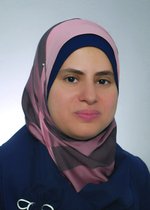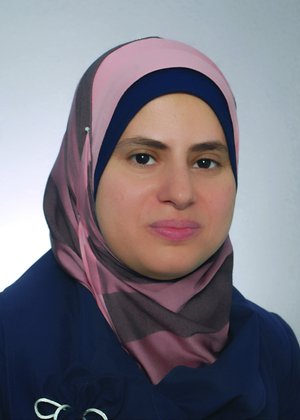سماح اشتية
- طبيعة العمل
- أكاديمي
- المهنة
- ق. أ رئيس قسم تمريض البالغين
- البريد الإلكتروني
- [email protected]


سماح اشتية
- طبيعة العمل
- أكاديمي
- المهنة
- ق. أ رئيس قسم تمريض البالغين
- البريد الإلكتروني
- [email protected]
- Course Title
- Intensive Clinical Nursing
- Course Number
- 7401401
- Instructor Name
- سماح اشتية
- Contact Information
- [email protected]
- Semester(s) and academic year(s)
-
Summer Semester 4
Second Semester 4
First Semester 4 - Compulsory / Elective
- Compulsory
- Course Description (course content):
This course offers a fourth year students the opportunity to be able to develop expertise and to implement problem solving and management principles in the nursing management of selected groups from the health-illness continuum and to practice nursing independently in three levels of prevention; primary, secondary, and tertiary at different clinical setting (hospital and community health centers). Students will apply theoretical knowledge to clinical settings with emphasis on leadership role, management and changing agent role, and taking full responsibility under the supervision of clinical instructors and nurse in charge of clinical setting as preceptors. The course also provide practice essential to the assessment, planning, implementation and evaluation of clients in different clinical setting as well as to apply nursing skills related to health promotion, health maintenance, health restoration and disease prevention and treatment among the target aggregates. This training will offer students the opportunity to take full responsibility as a charge nurse before graduation.
This course aims at providing clinical training opportunity for the fourth year nursing students to reinforce and integrate clinical skills and knowledge acquired during their study. The student will provide nursing care under the supervision of preceptors in the clinical areas of their choice with the guidance and indirect supervision of faculty members.
Intended learning Outcomes and Competences:
Aim of this Course
The course aims at preparing students to their professional clinical nursing role after graduation. It is designed to serve as a comprehensive clinical practice to enhance the students’ attainment of the program learning outcomes. Therefore the course’s intended outcomes are those for the whole program of BSc. degree in nursing which are as follow:
- Knowledge and Understanding:
By the end of this course the students will be able to:
A.1. Identify the essential basic knowledge and understanding related to key concepts of the disciplines that underpin the education and training of nursing and all health care professionals, and detailed knowledge of some of these. The latter would include a broad understanding of:
- the structure and function of the human body, together with a knowledge of dysfunction and pathology;
- health care philosophy and policy, and its translation into ethical and evidenced based practice;
- the relevance of the social and psychological sciences to health and nursing care;
A.2. Identify the essential knowledge base in carrying out nursing activities directed at preventing illness and promoting, maintaining, and restoring an optimal level of wellness.
- Intellectual skills
By the end of this course the students will be able to:
B1.1.Demonistrate the professional autonomy and accountability
B.2. Apply professional relationships
B.3. Compare between personal and professional skills
B.4.Apply leadership and sound professional practice
- Professional and practical skills
By the end of this course the students will be able to:
C.1. Build leadership and managerial skills in Clinical practice
C.2. Use Information gathering
C.3. Practice problem solving and resolution (decision making)
C.4. Utilize Communication skills
C.5. Numeric professional clinical skills
C.6. Apply Information technology
- General and transferable skills
By the end of this course the students will be able to:
D.1. Provide comprehensive patient care utilizing nursing process as a frame work according to the hospital criteria.
D.2. Perform all nursing procedures learned during his/her previous courses.
D.3. Demonstrate evidence of critical thinking in clinical decisions while providing direct patient care.
D.4. Apply theoretical knowledge in clinical practice.
D.5. Provide nursing care within ethical and legal principles.
D.6. Demonstrate ability to take safe and independent decisions in patient care.
D.7. Collaborate effectively with health team members.
D.8. Identify need for improvement based on his/her reflection of own clinical practice.
D.9. Participate actively in all roles of the staff nurses in the clinical setting.
D.10. Demonstrate effective oral and written communication skills as a professional nurse.
D.11. Team work
D.12. Independent learning
D.13. Follow measures of infections control.
D.14. prepare him\her for marketing themselves in practice profession
All books (latest edition) and articles required from the different nursing courses.
- Allender, J. A., Spradley, B.W. (2005). Community Health Nursing: Promoting and protecting public’s health. (6th Ed.). Lippincott Williams and Wilokins : Philadelphia.
- Bradley, J. C., (1990). Communication in the Nursing context. (3rd Ed.).
Appleton and Lang: Connecticut.
- Kozier, B., Erb, G. Berman, A., Synders, S., (2010). Fundamentals of Nursing : Concepts, Process and Practice. (9th Ed). Prentice Hall: NY.
- Marquis, B.L., & Huston C.J. (2009) Leadership Roles & Management Functions in Nursing: Theory & Application.
- Mosby’s Nursing Drug Reference 2008.
- Nieswindomy, R. M. (2010). Foundations of Nursing Research. 6tth Edition, Prentice Hall: New Jersy.
- Rubenfeld, M. Gaie, Scheffer Barbara. (2005). Critical thinking for Nurses. Jones Barlett:
- Sole, Mary Lu,Klein Deborah G and Moseby Marthe J.(2005). Introduction to Critical Care Nursing.(4th Ed.).Elsevier Saunders, St. Louis.
- Smelter S, Bare B, Hinkle J, & Kerry C. (2008) Publising. Brunner & Suddarth’s Text Book of Medical Surgical Nursing.(11th Edition). Lippincott Williams & Wilkins. (6th ed). Philadelphia: Lippincott Williams & Wilkins
10. Web sources (Website)
11. Other computer-based sources
12. Interactive Student Response Technology
13. Nursing Journals:
- American Journal of Nursing
- American Review of Nursing Research
- British Journal of Nursing
- Collaborative international research.
- Health Care for Women International.
- International Nursing Review
- Journal of Nursing Administration
- Jordan Medical Journal
- Nurse Education Today
- Nurse Practitioner
| Activity | Percent (%) |
|---|---|
| Preceptors and supervising faculty evaluation | 40% |
| Chang plan to take place at the clinical area -Written by hand case study and analysis on the clinical setting | 30% |
| Final Verbal\Oral case study exam by committee of faculty and external examiners-Clinical procedure exam | 30% |